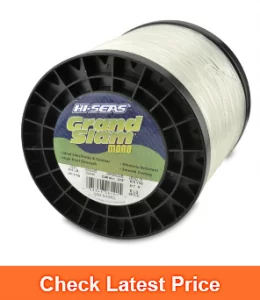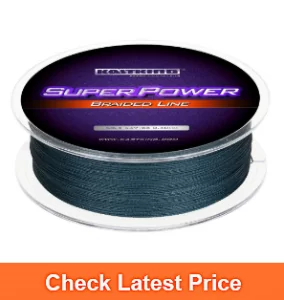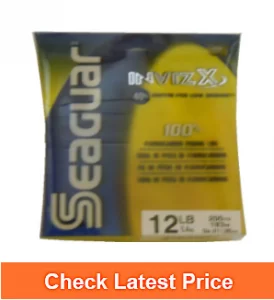Best Fishing Line in 2022 – Available in Market [Comparison Included]
Understanding Modern Fishing Line Technology
There is an incredible variety of fishing line on the market today, making it nearly impossible to identify one brand or type of line as definitively the best. The type of reel in use, the fish being targeted, and the fishing environment are all factors to be considered when homing in on the best fishing line for your purposes. Starting with a little basic knowledge will go a long way toward getting you set up right. Let’s cover some general background on modern fishing line types before we take a look at some of the top performers.
Line Types
The three main types of fishing line in common use today are mono filament, braided super line, and fluorocarbon line.
Almost anyone who has held a fishing rod in the past 50 years will be familiar with monofilament line. It has been around since the late 1930’s when Polyamide fibers were first invented and marketed as nylon.
Monofilament is a single strand made by melting different grades of polymers and mixing them with colors, softeners, and abrasion-resistant additives. This mixture is then extruded through tiny openings to produce the diameter and shape of line desired. Inexpensive, strong, easy to knot, and almost invisible in the water, monofilament was a great advance over the braided linen lines in use at the time. Early monofilaments tended to be stiff and difficult to work with, but by the 1950s, technology had been refined to produce line that was easier to handle. Monofilament sparked a revolution in line technology that lead to the great variety of artificial fiber fishing lines available today.
Braided line is one of the most ancient types of fishing line around. “Modern” braided Dacron lines were in use during the 1930s, but were low-performance in terms of knot-holding capabilities, breaking strength, and abrasion resistance. In the early 1990s, a new fiber called Ultra-High Molecular Weight Polyethylene (UHMWPE) was developed. Stronger than steel, stretch-free, and light enough to float, UHMWPE was used to create the super lines now used by fishermen around the world. The braided UHMWPE fibers can be left loose, creating a limp line like Spiderwire, or fused together to make a stiffer line like Berkley Fireline. The high strength of braid lets fishermen use a much smaller diameter line than comparable monofilament, and the lack of line stretch offers extreme sensitivity. The downside of braid is that it is not clear, making it necessary to add a monofilament leader when targeting line-shy fish.
Fluorocarbon Line is a newer type of monofilament made from a single strand of polyvinylidene fluoride (PVDF). Originally in common use as fly fishing leader material, fluorocarbon has been refined to make it limper and easier to handle when used as a main line. Fluorocarbon is very thinbut much stronger and less stretchable than standard monofilament. It also refracts light the same way water does, making it almost invisible. The high density of fluorocarbon makes the line run straighter between the rod and the lure, giving a more sensitive feel. On the other hand, the density also makes fluorocarbon heavy. It sinks quickly, which can be a disadvantage when using surface lures. Other downsides include low abrasion resistance and difficulty casting the line from a spinning reel due to its limpness and lack of memory.
Reeling in the Best Fishing Line
Now take a look at our reviews of some of the best of the monofilaments, braids, and fluorocarbons. Nearly every brand in each category offers a wide selection of line strengths and colors. We focused on the most popular choices for everyday recreational fishing in freshwater and coastal saltwater conditions. We looked at lines in the 20-30 lb weight range and also tried to stay around a budget-friendly price point. Read on to see what we found.
Table of Contents
4 Best Fishing Line Comparisons
Image | Product Name | Different Sizes | Brand | Price |
|---|---|---|---|---|
61 | Hi-Seas | |||
38 | KastKing | |||
25 | Berkley | |||
17 | Seaguar |
4 Best Fishing Line in 2020 - Review
Hi-Seas Grand Slam line offers one of the best values for the money in the monofilament category. The line is available in strengths from 400 all the way down to 6 pound test. We looked at the 40-pound test and were surprised at the low cost for 1,480 yards of line. This is definitely the line to use when you need to fill several large reels. The line is thicker than other lines in the same weight class and has a stiff feel to it. In our opinion, these factors plus high abrasion resistance make this a line that is good for use when heavier weight lines are needed for saltwater game fish and in other abusive conditions like fishing heavy brush or weed patches.
What we liked
- Tough, high-strength line
- Good knotting characteristics
- Excellent value
What we didn't like
- Stiffness makes it hard to manage on light reels
Braided superline can be quite expensive, so the KastKing SuperPower is a good find at one of the lowest per-yard costs of any of the braided lines we looked at. We like the overall characteristics of this line. The strands are wrapped very tightly, making for smaller diameter than other braids in the same 25 lb weight class. The line is very limp and smooth, but it still handles well off the reel, giving good casting distance without snarling. It is also easy to work with when tying knots. The user-friendly character of the line is likely due to KastKing’s proprietary coating technology. Just as strong as any braided line, this line is also highly abrasion resistant and did not start to have that fuzzy look after repeated use in rocky conditions. However, the line color does seem to wear off or fade for some reason. But strength and performance are not affected, and in terms of quality and value, KastKing is one of the best braided lines out there.
What we liked
- Handled better than other braided lines
- Smooth running through the guides
- Best value out there
What we didn't like
- Line coloring seems to rub off or fade easily
Berkley Fireline is one of the established names in the braided line sector. A 300-yard spool of this line in the 20 lb class comes at a relatively high price point. However, in heavy use conditions, the overall performance and durability of the line will make up for the cost. Fireline has three times the strength of monofilament, yet is very thin. We found that a reel backing of monofilament will be necessary to get the spool filled high enough. Once that aspect is tuned in, this line casts very well and handles better in breezy conditions than many other braided lines. The line has some memory at first, and is also a little noisy through the guides. This seems to be due to the coating, because the effects reduce as the line breaks in. The coating makes Fireline slip through the guides to cast far, but it also adds some stiffness. This makes Fireline braid better suited to spinning than baitcasting reels. Long-lasting performance, high-durability around sand and rocks, and easy handling characteristics make Fireline worth the extra cost.
What we liked
- Long casts
- Does not flutter around in the wind
- Handles tough coastal conditions without fraying
What we didn't like
- Needs some break-in time
- Comes at a high price point
Among the fluorocarbon lines, we like the SeaguarInvizx simply because it is one of the best values for the money in this line category. The price runs a bit high for shorter lengths, but with the bulk 1000 yard spool, you get a lot of high-performance fluorocarbon at a good price. We found that the Seaguar lives up to the purpose of fluorocarbon by being all but invisible. It also handles exceptionally well, giving long casts, tangle-free run out, and a sensitive feel in the water. Many fluorocarbon lines tend to feel stretchy, but the Invizix feels more like regular nylon monofilament. It has plenty of strength both straight and in the knot, and the hook-setting power is there when needed. Unlike others lines of this type, the Seaguar does not have a soft, easy-to-cut feel to it. Instead, it is hard and abrasion-resistant. This line also does not sink as fast as many other fluorocarbons. Go with Seaguar if you are looking for an easy-to-handle, tough, UV-resistant, low-memory fluorocarbon at a good price.
What we liked
- High strength and abrasion resistance
- Handles like nylon
- Good price
What we didn't like
- Under strength in the higher weight ranges


What’s Your Line?
There you have it – we sorted through the three main line types on the market today and came up with some good choices in each category. Personally, we like to spool spinning gear with a good fluorocarbon line even though it costs a bit more simply because we fish clear water a lot. Braid is good to go with bait casting outfits in murky, weedy lakes and ponds, and a nice, tough monofilament is great for taking general abuse at a low cost. In any case, matching the right line to the specific gear in use and water conditions being fished will absolutely have an effect on your success rate. It is well-worth it to have a selection on hand already spooled up on a variety of reels.
Related Resources
- Best Ice Fishing Gloves – Keep Your Hands Warm & Dry
- Best Fly Fishing Lines – Tested & Reviewed
- Haul Bass! with the Best Surf Cast Fishing Cart
- 10 Best Underwater Fishing Lights – Attract Fish Anywhere!
- Best Ice Fishing Fish Finders – Comparison Included
- Best Rain Gear for Fishing – Ultimate Guide From A Fishing Expert
![Best Fishing Line in 2022 – Available in Market [Comparison Included] Best Fishing Line](https://thefishingkayaks.com/wp-content/uploads/2017/12/Best-Fishing-Line.jpg)











hey man this is America and most these people think im stupid to want new 2019 line if i lose a fish i want it to be thru human error that equipment …
[…] Also Read: Best Fishing Line – Available in Market [Comparison Included] […]